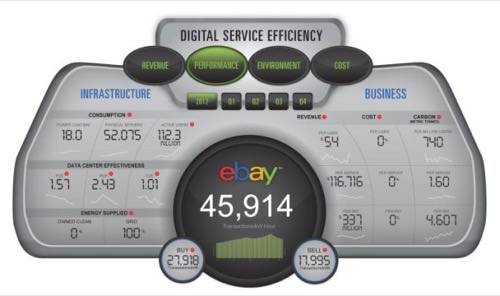
As part of its Digital Service Efficiency effort to reduce power consumption in its data centers, eBay slightly changed some of its software code so that the code would require less memory. Less memory meant more operations could be performed on the same server over a given amount of time.
The end result? eBay cut its power consumption by about a megawatt and took 400 servers out of its data centers, saving some $2 million in equipment costs.
“The ripple effect was gratifying,” said Dean Nelson, eBay’s vice president of Global Foundation Services during a break at the annual conference of The Green Grid. “We just changed the application a bit to save power.”
What Is Digital Service Efficiency (DSE)?
Digital Service Efficiency (DSE) is a metric that the auction giant hopes to popularize in the industry. In a nutshell, DSC divides the work accomplished by the power consumed. In eBay’s case, it divides the number of transactions and/or listings by the energy consumed. Energy used in searches is amortized across the entire operations. It is similar to the PUE (Power Use Effectiveness) rating developed by The Green Grid a few years ago, but it arguably is more targeted toward measuring power consumption and actual operations.
eBay’s figures don’t include all the crucial energy data — like how much gas gets consumed shipping a 1973-era Mattel Electronic Football game from Salt City, Mo., to a collector in San Jose, Calif. — but the numbers are still compelling. If anything, they underscore how data centers represent a more efficient way to conduct commerce than driving to the mall:
- eBay conducts 45,914 transactions per kilowatt hour. A medium-sized window-based air conditioner can consume a kilowatt hour in an hour.
- The company generates $337 million per megawatt hour.
- eBay has 52,075 servers that serve 112 million active users.
- It gets $116,716 in revenue per server.
- eBay racked up 7.3 trillion “transactions”, i.e. URL requests to buy or sell something, in 2012. That’s more than 1,000 transactions for every person on the planet.
The numbers come from eBay, so one can take them with a grain of salt, but the overall picture is pretty clear. The company serves a lot of customers fairly efficiently. At a minimum, the company is certainly doing its homework to make it as efficient as possible.

How Can DSE Help Save Money In The Datacenter?
eBay, for instance, has reduced the number of server configurations it will deploy down to two. Previously, it had 200 to 300 server configurations, with 15 of them accounting for 80% of the total population.) eBay now has a High Performance Computing (HPC) server designed to handle transactions. The HPC servers contain 72GB of memory and 4 hard drives. They are tuned, says Nelson, for rapid processing. A single rack can hold 96 of the servers, brining the total RAM per rack to 6,192GB.
Complementing the HPC servers are eBay’s Big Data servers, of which 48 can fit into a rack. Each Big Data server comes with a dozen 2TB drives. The Big Data servers can fit 1.2 petabytes of storage capacity per rack. The next Big Data servers may come with 3TB or 4TB drives, which would boost the total storage capacity in a rack to between two and three petabytes. Two petabytes can hold the same amount of information contained in all of the academic research libraries in the U.S. (Unlike Google or Facebook, however, eBay is not designing its own equipment in datacenters. Instead, it will buy from computer vendors.)
It has also created a showcase datacenter in Phoenix, dubbed Project Mercury, that utilizes modular containers to isolate equipment and pack it more densely along with liquid cooling. (If you can lower air conditioning bills in Arizona, you can lower them anywhere!)

The challenge now lies in balancing efficiency with necessary growth. Storage capacity, in particular, is set to explode.
“It is the storage, stupid,” Nelson said. “The volume of growth of storage is insane. We added 100 petabytes of capacity in the last 12 months.”

















